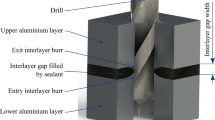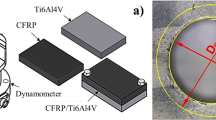Abstract
The mechanism of an interlayer gap formation and the influence of an interlayer gap in drilling of stacked metal materials were investigated. The interlayer gap formation is due to material bending by interlayer thrust force. The simplified analytical model was developed in order to show the relationship of the interlayer gap and the various factors, and the minimization of the interlayer gap depends mainly on the push-up force, the interlayer thrust force, and the flexural rigidity of each layer. The experimental research indicated that the interlayer gap size has a significant effect on interlayer burr size. When the interlayer gap is small enough, the effects of the material behavior and the cutting parameters will be attenuated. The different spatial size of burr formation causes the difference between the interlayer burr morphology and the surface layer burr morphology.
Similar content being viewed by others
References
Aurich JC, Dornfeld D, Arrazola PJ, Franke V, Leitz L, Min S (2009) Burrs—analysis, control and removal. CIRP Annals 58:519–542
Miguel A, Joel G, Corinne RW, Athulan V, David D (2006) Strategies for burr minimization and cleanability in aerospace and automotive manufacturing. UC Berkeley: Laboratory for Manufacturing and Sustainability. http://escholarship.org/uc/item/9ks6b6dp
Ko SL, Chang JE, Yang GE (2003) Burr minimizing scheme in drilling. J Mater Process Technol 140:237–242
Cantero JL, Tardío MM, Canteli JA, Marcos M, Miguélez MH (2005) Dry drilling of alloy Ti–6Al–4V. Int J Mach Tools Manuf 45:1246–1255
Rivero A, Aramendi G, Herranz S, López de Lacalle LN (2006) An experimental investigation of the effect of coatings and cutting parameters on the dry drilling performance of aluminium alloys. Int J Adv Manuf Technol 28:1–11
Nouari M, List G, Girot F, Coupard D (2003) Experimental analysis and optimisation of tool wear in dry machining of aluminium alloys. Wear 255:1359–1368
Ramulu M, Branson T, Kim D (2001) A study on the drilling of composite and titanium stacks. Compos Struct 54:67–77
Newton TR, Morehouse J, Melkote SN, Turner S (2008) An experimental study of interfacial burr formation in drilling of stacked aluminium sheets. Transactions of NAMRI/SME 36:437–444
Melkote SN, Newton TR, Hellstern C, Morehouse JB, Turner S (2009) Interfacial burr formation in drilling of stacked aerospace materials. In: Proceedings of the CIRP International Conference on Burrs: Analysis, Control and Removal, University of Kaiserslautern, Germany, pp. 89–98
Choi J, Min S (2003) Modeling of inter-layer gap formation in drilling of a multi-layered material. UC Berkeley: Laboratory for Manufacturing and Sustainability. http://escholarship.org/uc/item/2vb4t7gq
Liang J, Bi SS (2010) Design and experimental study of an end effector for robotic drilling. Int J Adv Manuf Technol. doi:10.1007/s00170-009-2494-9
Author information
Authors and Affiliations
Corresponding author
Rights and permissions
About this article
Cite this article
Jie, L. The formation and effect of interlayer gap in dry drilling of stacked metal materials. Int J Adv Manuf Technol 69, 1263–1272 (2013). https://doi.org/10.1007/s00170-013-5112-9
Received:
Accepted:
Published:
Issue Date:
DOI: https://doi.org/10.1007/s00170-013-5112-9




